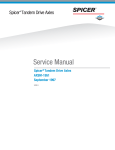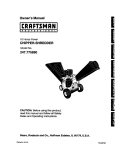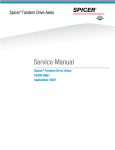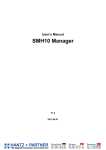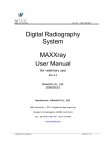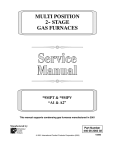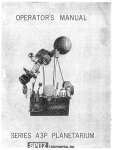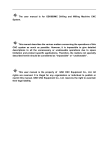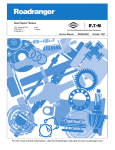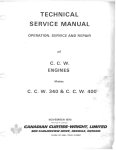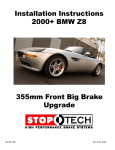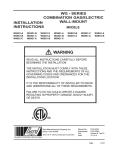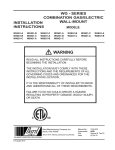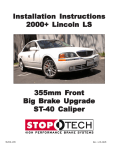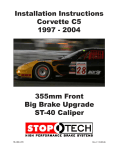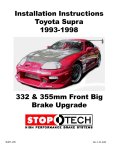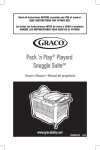Download Service Manual
Transcript
Spicer Drive Axles ® Service Manual Spicer® Drive Axles AXSM-8942 September 2007 TABLE OF CONTENTS Axle Identification Model Identification Numbering System Gear Set Identification Axle Lubricant Recommendations General Precautions Standard Axle Components Pinion-Up Axle Components Removal of Differential Carrier from Axle Housing Removal of Differential from Carrier Differential Disassembly Pinion Disassembly Cleaning and Inspection Pinion Assembly Pinion Position Differential Assembly Differential Installation Ring Gear and Pinion Tooth Contact Pattern Installation of Carrier into Axle Housing Fastener Torques and Axle Specifications Driver Controlled Differential Lock Driver Controlled Differential Lock Components Towing Procedures/Instructions Carrier Removal Removal of Diff-Lock Assembly Installation of Diff-Lock Assembly Carrier Installation Checking Differential Lock Operation Recommended Service Tools ○ ○ ○ ○ ○ ○ ○ ○ ○ ○ ○ ○ ○ ○ ○ ○ ○ ○ ○ ○ ○ ○ ○ ○ ○ ○ ○ ○ ○ ○ ○ ○ ○ ○ ○ ○ ○ ○ ○ ○ ○ ○ ○ ○ ○ ○ ○ ○ ○ ○ ○ ○ ○ ○ ○ ○ ○ ○ ○ ○ ○ ○ ○ ○ ○ ○ ○ ○ ○ ○ ○ ○ ○ ○ ○ ○ ○ ○ ○ ○ ○ ○ ○ ○ ○ ○ ○ ○ ○ ○ ○ ○ ○ ○ ○ ○ ○ ○ ○ ○ ○ ○ ○ ○ ○ ○ ○ ○ ○ ○ ○ ○ ○ ○ ○ ○ ○ ○ ○ ○ ○ ○ ○ ○ ○ ○ ○ ○ ○ ○ ○ ○ ○ ○ ○ ○ ○ ○ ○ ○ ○ ○ ○ ○ ○ ○ ○ ○ ○ ○ ○ ○ ○ ○ ○ ○ ○ ○ ○ ○ ○ ○ ○ ○ ○ ○ ○ ○ ○ ○ ○ ○ ○ ○ ○ ○ ○ ○ ○ ○ ○ ○ ○ ○ ○ ○ ○ ○ ○ ○ ○ ○ ○ ○ ○ ○ ○ ○ ○ ○ ○ ○ ○ ○ ○ ○ ○ ○ ○ ○ ○ ○ ○ ○ ○ ○ ○ ○ ○ ○ ○ ○ ○ ○ ○ ○ ○ ○ ○ ○ ○ ○ ○ ○ ○ ○ ○ ○ ○ ○ ○ ○ ○ ○ ○ ○ ○ ○ ○ ○ ○ ○ ○ ○ ○ ○ ○ ○ ○ ○ ○ ○ ○ ○ ○ ○ ○ ○ ○ ○ ○ ○ ○ ○ ○ ○ ○ ○ ○ ○ ○ ○ ○ ○ ○ ○ ○ ○ ○ ○ ○ ○ ○ ○ ○ ○ ○ ○ ○ ○ ○ ○ ○ ○ ○ ○ ○ ○ ○ ○ ○ ○ ○ ○ ○ ○ ○ ○ ○ ○ ○ ○ ○ ○ ○ ○ ○ ○ ○ ○ ○ ○ ○ ○ ○ ○ ○ ○ ○ ○ ○ ○ ○ ○ ○ ○ ○ ○ ○ ○ ○ ○ ○ ○ ○ ○ ○ ○ ○ ○ ○ ○ ○ ○ ○ ○ ○ ○ ○ ○ ○ ○ ○ ○ ○ ○ ○ ○ ○ ○ ○ ○ ○ ○ ○ ○ ○ ○ 2 3 3 4 5 6 7 8 9 10 12 13 14 17 19 20 21 22 23 24 25 26 27 28 29 30 31 32 GENUINE SPICER SER VICE P AR TS SERVICE PAR ARTS Should an axle assembly require replacement component parts, it is recommended that Spicer Heavy Axle Service Parts be used. Spicer Heavy Axle Service Parts are manufactured under the same rigid specification as are original equipment axle components. This assures the customer who uses genuine Spicer service parts, maximum reliability for a Spicer Heavy Axle assembly. They may be obtained through your vehicle manufacturer. The use of non-original Spicer service parts may cause premature component failure and may void the warranty. The items included in this book are currently being offered as service parts at the time of printing. The part numbers and illustrations are provided specifically for reference purposes only. Therefore, Spicer reserves the right to update this manual without notice or liability. 1 AXLE IDENTIFICA TION IDENTIFICATION All axle assemblies are identified with two tags. One located on the differential carrier, and the other located on the right hand side of the axle housing. JULIAN D ATE CODE DA 96 0 70 07 MODEL YEAR DAY OF YEAR ential carrier ttag ag contains the following: The differ differential Dana part number, julian date code, and ratio. Optional items include customer part number, line set number, and the last six digits of the vehicle serial number. DANA P AR T PAR ART NUMBER CUS TOMER CUST PAR T NUMBER ART (OPTIONAL) JULIAN D ATE DA CODE Carrier Tag LAS T SIX DIGITS OF LAST VEHICLE SERIAL NUMBER (OPTIONAL) Pinion Below Center DANA P AR T PAR ART NUMBER CUS TOMER CUST T NUMBER PAR ART (OPTIONAL) Axle Assembly Tag LAS T SIX DIGITS OF LAST VEHICLE SERIAL NUMBER (OPTIONAL) LINE SET NUMBER (OPTIONAL) MODEL JULIAN D ATE DA CODE Pinion Above Center LINE SET NUMBER (OPTIONAL) ssembl ag contains the following items: The axle aassembl ssemblyy ttag Dana part number, julian date code, axle model, and ratio. Optional items include customer part number, line set number, and the last six digits of the vehicle serial number. 2 MODEL IDENTIFICA TION NUMBERING SYSTEM IDENTIFICATION S 230 S L Family (S = Spicer) Nominal Load Carrying Capacity (230 = 23,000 Lbs.) (260 = 26,000 Lbs.) Gearing Type (S = Single Reduction) Options (N = *No-SPIN® Differential) (L = Driver Controlled Diff. Lock) (B = Bus) * No-SPIN® is a registered trademark of Tractech GEAR SET IDENTIFICA TION IDENTIFICATION Man ufactur er's Da Manufactur ufacturer's Datte- Date gear set was made. PINION ETCH SPICER TRADEMARK Spicer T ademark-- Company logo and location of Trrademark manufacturing facility. +15 th Combina tion(i.e. 4 Too ooth Combination(i.e. 41-1 1-11)- Indicates the pinion has 11 teeth and the ring gear has 41 teeth which results in a 3:73:1 ratio. 260 41-11 300GP2 03- Part number of pinion gear. (TYPICAL) 00GP20 TOOTH COMBINATION Ma tched Se Matched Sett Number Number-- Spicer ring gears and pinions are manufactured as matched sets. Both ring gear and pinion are marked with a corresponding number (i.e. 260), which identifies them as a matched set. PART NUMBER HEAT CODE SPICER TRADEMARK MFG. DATE MATCHED SET NUMBER 260 L10 A gear set that does not have the same match set numbers should not be run together. If either ring gear or pinion require replacement, a new matched set must be used. BACKLASH ETCH Backla sh Etch- Indicates backlash setting for assembly. Backlash Pinion Etch- Indicator for proper pinion position shim osition Section. stack up. See Pinion PPosition 3 AXLE XLE LUBRICANT RECOMENDATIONS To ensure proper lubrication and operating temperature, correct lubricants and lubricant levels must be obtained. APPLICA TION APPLICATION On Highway PETR OLEUM B ASED PETROLEUM BASED MILES INTER VAL INTERV S YNTHETIC B ASED** SYNTHETIC BASED** MILES INTER VAL INTERV 100,000 1 Year 250,000 3 Year and 50,000 On-Off Highway 1 Year 100,000 1 Year RECOMMENDED GEAR LUBRICANTS * Severe Service Mineral or Synthetic based hypoid gear lubricants that meet or exceed military specification MIL-L-2105D, and API service classification GL-5, are the minimum requirements for use in Spicer Medium and Heavy Duty Drive Axles. * Severe service includes any applications operating at or near maximum GVW or GCW ratings. This includes normally wet or dusty environment, or consistent high load and low speed applications. The table below indicates which SAE viscosities are recommended for various temperature ranges the vehicle will encounter. ** Includes Semi-Synthetic blends that meet MIL-L-2105D specifications. AFTER OVERHAUL OR CHANGE INTERVALS Fill the axle assembly to the bottom of housing fill hole as shown in the illustration below. It is recommended that following an overhaul, each side of the axle be jacked up seperately to approximately six inches and held into position for one minute. This procedure will allow adequate lubricant to flow into the wheel ends and help eliminate the possibility of premature damage to wheel bearings and seals. Lower the vehicle to the floor and allow ten minutes for lube to return to normal level. Check and refill assembly to bottom of fill hole to replace the lubricant that was directed into the wheel ends. SAE 140 SAE 85W-140 SAE 90 SAE 80W-140 SAE 80W SAE 75W-140 SAE 75W-90 SAE 75W Cº -40 -26 -12 -40 -15 +10 +32 +40 Fº 0 +4 +15 +27 +38 Cº +60 +80 +100 Fº AMBIENT AIR TEMPERATURE SERVICE Recommended lubricant change intervals are dependent on the application and operating environment. The following chart should be used to establish proper change intervals. SUBMERSION OR DEEP WATER FORDING NO TE: Lubricant close enough to the bottom of the fill hole to be seen or NOTE: touched is not sufficient. Lubricant must be level with the fill hole. In the event the carrier housing should become submerged in water, particularly if over the vent or breather, it is recommended that the lubricant be drained and all internal parts be inspected for water damage and/or contamination. Reassemble the carrier to the housing and refill with specified gear lubricant. 4 GENERAL PRECAUTIONS IMPOR TANT IMPORT READ THIS SECTION BEFORE ST AR TING STAR ARTING ANY SER VICE PROCEDURES SERVICE GENERAL AXLE DESCRIPTION Accordingly, anyone who uses a service procedure or tool different than shown must insure that their safety, and the vehicle's safety, will not be jeopardized by the service method selected. This manual covers maintenance and rebuild procedures for the Spicer S230-S, S230-SL, and S260-SB rear drive axle assemblies. The Spicer Heavy Duty Single Reduction rear drive axle is a full floating axle assembly, with a hypoid gear carrier assembly, using a High Strength Low Alloy (HSLA) steel axle housing. The hypoid pinion is straddle mounted with two tapered roller bearings behind the pinion teeth for thrust and radial loads. A pilot bearing is located on the nose of the pinion for radial load. The differential itself uses four precision forged pinion mate gears, a forged cross, and precision forged side gears. END YOKES AND FLANGES CA UTION: Hammering on end yyok ok CAUTION: okees can close in the bearing bor ok borees or misalign yyok okee lugs and rreesult in earl ther earlyy failur failurees of journal needle bearings or oother eline component s. Serious damage can also be driv driveline components. done int ernall o the ring and pinion se internall ernallyy tto sett or pinion ok xt ernal par bearings bbyy hammering on eext okees xternal partts. End yyok or companion flange emo alled flangess should be rremo emovved or inst installed using the rrecommended ecommended me thods outlined in this methods man ual. manual. Safety glasses should be wor n worn at all times when assembling or disassembling axles. CLEANLINESS Axle components should be steam cleaned prior to removal from the vehicle. Dirt is abrasive and will cause premature wear of otherwise serviceable parts. Service personnel should use a wash tank for thorough cleaning of parts just prior to reassembly. SAFTEY PRECAUTIONS Proper service and repair of vehicle components is important to the safe and reliable operation of all motor vehicles. This applies particularly to driving axles such as the ones described in this manual. The procedures recommended and described in this manual are tested, effective methods for performing service operations. Follow each procedure closely, making use of both the text and illustrations. Some of these service procedures show the use of certain tools designed specifically for the operation being performed. They are shown as a preferred means of performing the operation. It is not practical to anticipate and advise the service trade of all possible alternative methods, and of all possible hazardous consequences that could occur. CAUTION BR AKE LININGS CONT AIN NON-ASBES TOS FIBER S BRAKE CONTAIN NON-ASBEST FIBERS BREA THING BR AKE DUS T MA Y BE HAZARDOUS T OY OUR HEAL TH AND BREATHING BRAKE DUST MAY TO YOUR HEALTH MA Y CA USE SERIOUS RESPIR ATOR Y OR O THER BODIL Y HARM. MAY CAUSE RESPIRA ORY OTHER BODILY AVOID CREA TING DUS T CREATING DUST VE BR AKE DR UM WITHOUT PR OPER PR OTECTIVE EQ UIPMENT NOT REMOVE BRAKE DRUM PROPER PRO EQUIPMENT UIPMENT.. DO NO T REMO OPER PR OTECTIVE EQ UIPMENT NOT WORK PROPER PRO EQUIPMENT UIPMENT.. DO NO T W ORK ON LININGS WITHOUT PR OPER PR OTECTIVE EQ UIPMENT NOT REPLACE PROPER PRO EQUIPMENT UIPMENT.. DO NO T REPLA CE LININGS WITHOUT PR TER BR AKE NOT ATTEMPT TO SAND, ALTER BRAKE DO NO TA TTEMPT T OS AND, GRIND, CHISEL, FILE, HAMMER OR AL PROPER PRO EQUIPMENT UIPMENT.. LININGS IN ANY MANNER WITHOUT PR OPER PR OTECTIVE EQ UIPMENT FOLL OW 0.S.H.A. S TAND ARDS FFOR OPER PR OTECTIVE DEVICES T O BE USED OLLO ST ANDARDS PROPER PRO TO OR PR ORKING WITH BR AKE MA TERIALS. WORKING BRAKE MATERIALS. WHEN W 5 ST ANDARD AXLE COMPONENTS STANDARD Axle Shaft Housing Breather Differential Bearing Cap Bolt (295 - 340 Lb-Ft) (400 - 461 N-m) Fill Plug (35-45 Lb-Ft) (47 - 61 N-m) Temperature Sensor Plug (35 - 45 Lb-Ft) (47 - 61 N-m) Washer Drain Plug (35 - 45 Lb-Ft) (47 - 61 N-m) Differential Bearing Adjusting Ring Differential Bearing Cup Differential Case Half Differential Bearing Cap Differential Bearing Cone Differential Case Flange Half Adjusting Ring Lock Ring Gear Ring Gear Rivet (45-50 tons) (41-45 metric tonnes) Thrust Washer Differential Pinion Mate Differential Cross Shaft Differential Side Gear Thrust Washer Differential Case Bolt (160 - 180 Lb-Ft) (217- 244 N-m) Adjusting Ring Lock Bolt (20 - 30 Lb-Ft) (27 - 41 N-m) Ring Gear Bolt Kit - Service No-Spin® Differential Carrier Mounting Bolt (240 - 260 Lb-Ft) (325 - 353 N-m) Inner Pinion Bearing Cone Inner Pinion Bearing Cup Pinion Preload Spacer (Selective) Pinion Position Shim Pinion Bearing Cage Outer Pinion Bearing Cup Carrier Housing Pilot Bearing Bearing Cage Bolt (160-180 Lb-Ft) (217- 244 N-m) Outer Pinion Bearing Cone Pinion Pinion Seal End Yoke Assembly Pinion Hex Nut (900 - 1,200 Lb-Ft) (1,220 - 1,627 N-m) 6 Washer PINION-UP AXLE COMPONENTS Axle Shaft Housing Breather Differential Bearing Cap Bolt (295 - 340 Lb-Ft) (400 - 461 N-m) Fill Plug (35-45 Lb-Ft) (47 - 61 N-m) Temperature Sensor Plug (35 - 45 Lb-Ft) (47 - 61 N-m) Washer Drain Plug (35 - 45 Lb-Ft) (47 - 61 N-m) Differential Side Gear Differential Bearing Adjusting Ring Differential Cross Shaft Differential Bearing Cup Differential Bearing Cap Thrust Washer Adjusting Ring Lock Adjusting Ring Lock Bolt (20 - 30 Lb-Ft) (27 - 41 N-m) Ring Gear Differential Bearing Cone Differential Case Bolt (160 - 180 Lb-Ft) (217- 244 N-m) Differential Case Half Differential Pinion Mate Thrust Washer Ring Gear Rivet (45-50 tons) (41-45 metric tonnes) Differential Case Flange Half Carrier Mounting Bolt (240 - 260 Lb-Ft) (325 - 353 N-m) Pinion Preload Spacer (Selective) Pinion Position Shim Pinion Bearing Cage Bearing Cage Bolt (160-180 Lb-Ft) (217- 244 N-m) Pilot Bearing Carrier Mounting Bolt (240 - 260 Lb-Ft) (325 - 353 N-m) Carrier Housing Pinion End Yoke Assembly Inner Pinion Bearing Cone Inner Pinion Bearing Cup Washer Outer Pinion Bearing Cup Outer Pinion Bearing Cone Pinion Seal 7 Pinion Hex Nut (900 - 1,200 Lb-Ft) (1,220 - 1,627 N-m) REMOV AL OF DIFFERENTIAL REMOVAL CARRIER FROM AXLE HOUSING IMPOR TANT ehicle is equipped with driv er IMPORT ANT:: If the vvehicle driver contr olled differ ential lock, see instructions begining controlled differential on page 2 4. T o tto ow a vvehicle ehicle with driv er contr olled 24. To driver controlled 6. differ ential lock, see instructions on page 2 differential 26. 8. Use a breaker bar to loosen the differential carrierto-housing mounting bolts. Remove all bolts except top two. These two bolts will prevent the carrier assembly from falling. NO TE: St eam clean axle aassembl ssembl NOTE: Steam ssemblyy. 9. Separate differential carrier from the housing using igur removal slots. See FFigur iguree 1. Be certain carrier is balanced properly on jack, and remove top two carrier-to-housing mounting bolts. Remove differential carrier assembly from the axle housing. 1. Block wheels. 2. Remove axle housing drain plug and drain lubricant. 3. Disconnect drive shafts at the rear U-joint. NO TE: If end yyok ok o be rreplaced, eplaced, NOTE: okee and/or seal is tto loosen yyok ok ut aatt this time. okee nnut 4. Remove axle shaft flange nuts. 5. Hold a large brass drift or a brass hammer against the center of the axle shaft flange. Strike the drift with sharp blows from a large hammer or sledge until the axle shaft separates from the hub. CA UTION: Do no ectl CAUTION: nott strik strikee the flange dir directl ectlyy with a st eel hammer or sledge. This ma ack and steel mayy cr crack splint er ma splinter matterial, possibl possiblyy causing serious or fa fattal injury way fr om hhub ub injury.. Do no nott pry or chisel axle flange aaw from or damage tto o sealing sur face surface facess could occur occur.. Remo emovval slot Remo emovval slot Figur iguree 1 6. Remove axle shafts. 10. Mount carrier assembly in a suitable rebuild stand. ools (Refer to Recommended Service T Tools ools, pg. 32). 7. Support the differential carrier assembly on a roller jack. Secure as necessary to prevent it from falling off the jack when removed from the housing. Differ ential Carrier RRemo emo Differential emovval Complet Completee 8 REMOV AL OF DIFFERENTIAL FROM CARRIER REMOVAL 1. Remove adjusting ring locks from bearing caps. 3. Loosen four bearing cap retainer bolts. 2. Match mark one differential bearing cap and leg with center punch or chisel for correct reassembly. See Figur iguree 2. 4. Loosen adjusting rings, relieving bearing preload. 5 . Remove four bearing cap retainer bolts. 6. Remove bearing caps. 7. Remove adjusting rings. 8. Carefully lift the ring gear and differential subassembly out of the carrier. NO TE: Use car o damage the ring gear and NOTE: caree no nott tto pinion. If either ring gear or pinion sho w signs of show damage, the ust be rreplaced eplaced aass a ma tched se t. theyy m must matched set. RRemo emo ential Complet emovval of Differ Differential Completee Figur iguree 2 9 DIFFERENTIAL DISASSEMBL Y DISASSEMBLY Differential Bearing Cone Thrust Washer Differential Bearing Adjusting Ring Differential Bearing Cup Differential Case Half Differential Bearing Cone Ring Gear Differential Bearing Cup Ring Gear Rivet (45-50 tons) Differential Pinion Mate Differential Cross Shaft Differential Side Gear Thrust Washer Differential Case Half Differential Bearing Adjusting Ring Differential Case Bolt (160-180 Lb-Ft) (217- 244 N-m) 1. Match mark differential case halfs with punch or chisel for correct alignment in reassembly. See FFigur igur iguree 3. 2. Remove differential case bolts and lift off differential case half. 3. Remove thrust washer and differential side gear. 4. Lift out cross shaft, pinion mates, and thrust washers. 5. Remove second differential side gear and thrust washer. 6. If differential side bearings are to be replaced, remove old bearings using a suitable puller. See FFigur igur iguree 4. Figur iguree 3 10 DIFFERENTIAL DISASSEMBL Y DISASSEMBLY CORRECT PROCEDURE Ca se Case Ring Gear CA UTION: Alw CAUTION: Alwaays use a soft hammer or H.D. pla stic head hammer tto o strik plastic strikee punch. INCORRECT PROCEDURE Figur iguree 4 NO TE: Inspect all par NOTE: partts, including the machined se half sur face surface facess of the ca case half.. Ring Gear Ca se Case If an o be rreplaced, eplaced, the ust be anyy gear gearss ar aree tto theyy m must tched se replaced in ma sherss matched setts. Inspect thrust w waasher ear eplace all w orn for scoring and eexxce ssiv ssivee w wear ear.. RReplace worn cessiv or damaged par partts. NO TE: Ring gear bolt kit eplaceNOTE: kitss ar aree aavvailable aass a rreplacement for ring gear riv ar ual for riveets, see PPar artts List man manual par umber informa tion. partt nnumber information. NO TE: Do no o rremo emo NOTE: nott use a chisel tto emovve riv riveet heads, se ma damage tto o differ ential ca differential case mayy rreesult. 7. When it is necessary to remove ring gear from the differential case, carefully center punch each rivet head. Use a 9/16 inch drill bit. Drill through rivet heads to depth shown. Next, use a rounded type punch to drive out remaining portion of the rivet. Differ ential Disa ssembly Complet Differential Disassembly Completee 11 PINION DISASSEMBL Y DISASSEMBLY Pinion Bearing Cage Outer Pinion Bearing Cup Carrier Housing Bearing Cage Bolt (160-180 Lb-Ft) (217-244 N-m) Pilot Bearing Pinion Outer Pinion Bearing Cone Inner Pinion Bearing Cone Pinion Seal End Yoke Assembly Washer Inner Pinion Bearing Cup Pinion Preload Spacer (Selective) Pinion Position Shim(s) Pinion Hex Nut (900 - 1,200 Lb-Ft) (1,220 - 1,627 N-m) 6. Located between the pinion bearings is a selective bearing preload spacer. Retain this selective preload spacer for possible use during reassembly. 1. Remove pinion bearing cage mounting bolts. 2. Remove pinion assembly from carrier housing. If difficulty is encountered in removing pinion assembly from carrier housing, place a brass drift on inner end of pinion and tap lightly with hammer. 7. Remove the old pinion seal and discard. Always use a new seal at the time of reassembly. 8. Lift out the outer pinion bearing cone. NOTE: NO TE: RReetain shims for possible use during rea ssembl eassembl ssemblyy. 9. Remove inner pinion bearing cup, using a suitable adapter and press or puller. 3. Hold yoke stationary. Remove nut and washer. A torque multiplier may be required to loosen nut. CA UTION: Do no e. CAUTION: nott nick bearing bor bore. 4. Remove the end yoke using a suitable puller. See Recommended Service T ools Tools ools, pg. 32. 10. Remove the outer pinion bearing cup, use the same procedure as in step 9. 5. Remove pinion from cage assembly. 11. Remove pilot bearing from end of pinion. ssary tto o ttap ap out er end of NO TE: It ma outer NOTE: mayy be nece necessary pinion with a soft hammer aking car o damage hammer,, ttaking caree no nott tto thr eads. threads. 12. Remove inner bearing cone from pinion. Pinion Disa ssembly Complet Disassembly Completee 12 CLEANING AND INSPECTION CLEANING GEARS 1. Parts should be cleaned with emulsion cleaners or petroleum base cleaning solvent. NO TE: Alk aline ttype ype solutions ma o NOTE: Alkaline mayy cause damage tto machined sur face surface facess and should be aavvoided. 2. Make sure interior of axle housing is clean prior to reassembly. 3. Clean all gasket surfaces of old material. DRYING Use soft, clean, lintless towels or rags to dry components after cleaning. Bearings should NOT be dried by spinning with compressed air. This can damage mating surfaces due to the lack of lubrication. Inspect gears for excessive wear or damage. Replace gears that are pitted, scored, broken, or worn. SHAFTS After drying, parts should be coated with a light coat of lubricant or rust inhibitor to prevent damage from corrosion. If parts are to be stored for a prolonged period, they should be wrapped in wax paper. INSPECTION Inspect shafts for nicks or scoring. Prior to reassembly, inspect parts for signs of excessive wear or damage. Replacement of these parts can prevent premature failure and costly downtime. SPLINES BEARINGS Inspect all splines for excessive wear, distortion from twisting, and cracking. HOUSINGS Bearing surfaces should be inspected for pitting, excessive wear, or overheating. THRUST WASHERS Inspect housing for stripped threads and bending fatigue. Inspect thrust washers for scoring and cracking. 13 PINION ASSEMBL Y ASSEMBLY Pinion Bearing Cage Outer Pinion Bearing Cup Carrier Housing Bearing Cage Bolt (160-180 Lb-Ft) (217- 244 N-m) Pilot Bearing Pinion Outer Pinion Bearing Cone Inner Pinion Bearing Cone Pinion Seal End Yoke Assembly Washer Inner Pinion Bearing Cup Pinion Preload Spacer (Selective) Pinion Hex Nut (900 - 1,200 Lb-Ft) (1,220 - 1,627 N-m) Pinion Position Shim(s) 1. Press inner pinion bearing cone onto pinion. 2. Press Pilot bearing onto the pinion. 5. Install outer pinion bearing cup into pinion bearing cage. 3. Stake Pilot bearing in nine places (See illustration below), using a center punch or equivalent tool. This operation will move gear shaft material outward into bearing chamfer. 6. Use a feeler gauge or shim stock (.002 in. Max.) to ensure bearing cups are completely seated in bearing bores. This is necessary for the proper igur pinion position. See FFigur iguree 5. Figur iguree 5 4. Install inner pinion bearing cup into pinion bearing cage. 7. Place the selective preload spacer, that was removed during disassembly, onto pinion. 14 PINION ASSEMBL Y ASSEMBLY Me thod A uses a pull scale and a strong cord approxiMethod thod B uses a Lb-in mately 8 ft. long. (See Item 11). Me Method torque wrench. Both methods measure torque to rotate. (See Item 12). 8. Place pinion bearing cage onto inner pinion bearing. 9. Install the outer pinion bearing cone onto pinion. 10. Without installing seal, install end yoke onto pinion igur using yoke installer service tool. See FFigur iguree 6. This will allow proper setting of pinion preload. Secure yoke with a Yoke and Flange Holding Bar or an equivalent tool. Install pinion nut and washer. Torque pinion nut to 900-1,200 Lb-Ft (1,2201,627 N-m). 11. Me thod A: To measure torque-to-rotate with the Method spring scale, clamp the end yoke horizontally in a soft-jawed vise. Attach one end of the cord to a bolt hole in the pinion cage, wrap cord around pinion cage and attach the outer end of the cord to the spring scale. Rotate pinion cage by pulling scale. Read scale during fourth revolution. Scale reading must be between 3-10 Lbs (1.4-4.5 Kg) See Figur iguree 7. NO TE: Inspect end yyok ok face for gr oo NOTE: okee seal sur surface groo oovves caused bbyy lip of seal. If gr oo ed with groo oovves can be de dettect ected fingernail, it should be rreplaced. eplaced. Figur iguree 7 Figur iguree 6 (Continued on Ne xt PPage) age) Next CA UTION: The pinion cage should be rro otated CAUTION: periodicall ening the pinion nnut ut tto o sea periodicallyy while tight tightening seatt and align the pinion bearings. There are two methods of measuring pinion bearing preload and both are acceptable. Mechanic's preference and available tools should determine which method is used. 15 PINION ASSEMBL Y ASSEMBLY Inche Inchess .896 .897 .898 .899 .900 .901 .902 .903 .904 .905 .906 .907 .908 .909 .910 .911 .916 12. Me thod B: To measure torque to rotate with the Method torque wrench, assemble pinion cage into the carrier housing and install two mounting bolts to anchor the unit. Rotate pinion with the torque wrench. See FFigur iguree 8 8. igur Torque measurement will be taken during fourth revolution and must be between 10-40 Lb-in (1.1-4.5 N-m) without pinion seal. NO TE: Closer adjustment can be made bbyy sanding NOTE: ne xt thick er spacer tto o de sir ed thickne ss using emery next thicker desir sired thickness clo th on a fla face. Sur face ust be par allel tto o cloth flatt sur surface. Surface facess m must parallel each oother ther and squar o bor squaree tto boree diame diametter er.. Figur iguree 8 CA UTION: W oughl CAUTION: Waash spacer thor thoroughl oughlyy of emery NO TE: When ttor or que tto o rro otate rreading eading doe NOTE: orque doess no nott fall within allo wable limit s, bearing pr eload can be allow limits, preload incr ea sed bbyy using a thinner spacer or decr ea sed bbyy increa eased decrea eased 1 in. (.0 25 mm) change in using a thick er spacer .001 (.02 thicker spacer.. .00 eading bbyy pr eload spacer thickne ss, change preload thickness, changess scale rreading appr oxima 0 lbs, .00 1 in. change in pr eload ximattel elyy 1 10 .001 preload appro spacer will change ttor or que tto o rro otate bbyy appr oxima orque appro ximattel elyy 30 Lb- in. This is onl onlyy a guide, individual carrier carrierss ma mayy vary slightl slightlyy. alling on pinion. cuttings beforee inst installing cut tings befor 14. After proper torque to rotate is achieved remove end yoke. 15. Clean and dry threads on pinion. 16. Install pinion oil seal with Recommended Service Tool ool. See page 32. The pinion bearing spacers are available in the following thicknesses. Measure spacer with micrometers before assembly to ensure correct thickness. Inche Inchess .893 .894 .895 MM 22.758 22.784 22.809 22.835 22.860 22.885 22.911 22.936 22.962 22.987 23.012 23.038 23.063 23.089 23.114 23.139 23.266 17. Install end yoke using yoke installer service tool igur DST1007. See FFigur iguree 6. 18. Coat threads with Loctite #680 adhesive compound. MM 22.982 22.708 22.733 (Continued on Ne xt PPage) age) Next 16 PINION POSITION 19. Install pinion nut and washer. Use torque multiplier and torque pinion nut to 900-1,200 Lb-Ft (1,2201,627 N-m). If a new gear set is being used, notice the (+), (–) or "0" etching on both the old and the new pinions, and adjust the thickness of the shims to compensate for the difference of these two figures (as shown in table on next page). Pinion assembly is now ready to be installed into carrier housing. For example, if the old pinion is etched +2, and the new pinion is –2, subtract .004 in. from the thickness of the original shims used to position the pinion. Pinion Assembly Complet Completee Ring gears and pinions are supplied in matched sets only. Matching numbers on both the pinion and ring gear are etched for verification. If a new gear set is being used, verify the numbers of each pinion and ring gear before proceeding with assembly. If either or both the pinion gears are etched beyond the values on this chart, follow the same procedure to establish correct pinion position. For example if the old pinion is etched –12 and the new pinion is etched +9, add .021 inch to the thickness of the original shims. When a new gear set is being installed, use a micrometer to measure the thickness of the old pinion position shims. Measure each shim separately and add together to get the total thickness of the original build-up. After determining the new total build up of pinion position shims, round the figure off to the nearest multiple of .005 inch. NO TE: If old shims ar utila NOTE: aree bent or m mutila utilatted the theyy should be rreplaced. eplaced. Use the Pinion Setting Chart on the next page as a guideline to set the pinion. 17 PINION SETTING CHAR T CHART 18 DIFFERENTIAL ASSEMBL Y ASSEMBLY Differential Bearing Cone Thrust Washer Differential Bearing Adjusting Ring Differential Bearing Cup Differential Case Flange Half Differential Bearing Cone Ring Gear Differential Bearing Cup Ring Gear Rivet (45-50 tons) (41-45 metric tonnes) Differential Pinion Mate Differential Cross Shaft Differential Side Gear Thrust Washer Differential Case Half Differential Bearing Adjusting Ring Differential Case Bolt (160 - 180 Lb-Ft) (217 - 244 N-m) Corr ect riv et head shape Correct rivet operly compr properly compreessed when pr 3. Apply a small amount of gear lubricant to all mating surfaces. This will aid in assembly by keeping parts together and providing initial lubrication. 4. Place thrust washer and side gear in differential case flange half. 5. Assemble pinion mates and thrust washers onto differential cross shaft. Place assembly into flange half differential case. 1. If ring gear was removed from the differential case, reinstall it at this time. Bolt ring gear to differential case in three places, 120° apart, before compressing rivet; this will eliminate ring gear runout. Use a hydraulic or mechanical press and riveting fixture. Pressure requirement per rivet is 45-50 U.S. tons or (41-45 metric tonnes). 6. Place remaining side gear and thrust washer in position on differential pinion mates. 7. Assemble case halves, making sure match marks are lined up. 8. If reinstalling used bolts, clean threads and apply Loctite #277. Install differential case bolts and torque evenly to 160-180 Lb-Ft (217- 244 N-m). 2. Press bearing cones onto differential case halves. Place bearing cups on cones during remainder of assembly to prevent damage of bearings. Differ ential Assembly Complet Differential Completee NO TE: Ring gear bolt kit eplaceNOTE: kitss ar aree aavvailable aass a rreplaceual for par ment for ring gear riv riveets, see par partts list man manual partt number informa tion. information. 19 DIFFERENTIAL INST ALLA TION INSTALLA ALLATION 1. Install ring gear and differential assembly into carrier housing. 4. Loosen adjusting ring on tooth side of ring gear one notch and tighten adjusting ring on flange side of ring gear one notch. Repeat process until backlash is eliminated. Tighten adjusting ring on tooth side of the ring gear until the ring gear and pinion backlash matches the backlash etched on the ring gear. This adjustment sets both the backlash and the bearing preload. CA UTION: T o aavvoid damage of ring gear and pinion, CAUTION: To car alling the ring gear caree should be used when inst installing differ ential aassembl ssembl o the carrier housing. differential ssemblyy int into 2. Be sure side bearing cups are seated on bearing cones. Assemble differential bearing caps, with match marks in proper location. Clean bearing cap bolts and washers and coat threads with Loctite #277. Install bearing cap bolts and tighten enough to draw bolt head into contact with bearing cap, eliminating visible space between differential bearing cap and carrier housing. Do not torque the cap bolts at this time. 5. Check ring gear and pinion backlash in four equally spaced positions around the ring gear with a dial igur 0. A ccep indicator as shown. See FFigur iguree 1 10. Accep ccepttable backla sh ttoler oler ance is +/- .00 2" fr om backla sh backlash olerance .002" from backlash etched on ring gear gear.. CA UTION: Differ ential aassembl ssembl ust be CAUTION: Differential ssemblyy m must eload is applied aligned within bearing bor borees befor beforee pr preload or damage tto o bearings can occur occur.. Figur 0 iguree 1 10 NO TE: If the backla sh ttoler oler ance doe ary mor NOTE: backlash olerance doess no nott vvary moree 80 mm), the se than .00 4 in. (.0 accepttable. If .004 (.08 settting is accep backla sh doe ary mor 4 in. (.0 80 mm), .004 (.08 backlash doess vvary moree than .00 ential and de remo emovve the differ differential dettermine the cause. Figur iguree 9 6. Once backlash is set, torque the differential bearing cap bolts to 295-340 Lb-Ft (397-460 N-m). Check backlash after torquing cap bolts. 3. Install adjusting rings. Tighten both adjusting rings until end play is eliminated, and there is backlash igur iguree 9. between the ring gear and pinion. See FFigur 20 RING GEAR AND PINION TOOTH CONT ACT P ATTERN CONTACT PA PR OFILE PROFILE The following procedures are to be used to establish proper gear tooth pattern after assembly of the carrier is complete. eused, mea NO TE: If ma tched se aree being rreused, measur suree NOTE: matched setts ar sur ea sand rrecor ecor d backla sh befor ssembl easecord backlash beforee disa disassembl ssemblyy, and rrea semble tto o the same backla sh. This will ma tch ring backlash. match and pinion gear o the eest st ablished w ear pa gearss tto stablished wear pattterns. Hand rrolled olled pa ss ar ea than the pattterns will co covver le less area gear pa st ablished bbyy pr patttern eest stablished preevious service. TOP LAND TOE CO AS T SIDE COAS AST LENGTHWISE ARC BEARING AR C HEEL DRIVE SIDE ROO T OOT STEP 1. Paint 1/4 ring gear with marking compound on both the drive and coast side. STEP 2. Apply drag load to ring gear and rotate pinion so that ring gear completes one revolution in each direction. CORRECT GEAR P ATTERNS PA LIGHTL Y LLO OADED LIGHTLY HEA VIL Y LLO OADED HEAVIL VILY TOE TOE HEEL HEEL HEEL DRIVE SIDE (CONVEX) COAST SIDE (CONCAVE) HEEL DRIVE SIDE (CONVEX) COAST SIDE (CONCAVE) INCORRECT GEAR P ATTERNS PA HEA VIL Y LLO OADED HEAVIL VILY LIGHTL Y LLO OADED LIGHTLY TOE TOE HEEL DRIVE SIDE (CONVEX) HEEL HEEL COAST SIDE (CONCAVE) DRIVE SIDE (CONVEX) 21 HEEL COAST SIDE (CONCAVE) INST ALLA TION OF DIFFERENTIAL INSTALLA ALLATION CARRIER INTO AXLE HOUSING 7. Install the new axle flange gasket. 1. Thoroughly clean the inside of the carrier housing and inspect the housing mounting surface for nicks and general cleanliness. Stone the surface if necessary to remove burrs or nicks. Bolt holes must also be checked, to see that they are free of contaminants. 8. Install the axle shafts to proper location. Torque the axle flange nuts to vehicle manufacturers specifications. 9. Clean drain plug and install. Torque drain plug to 35-45 Lb-Ft (47-61 N-m) Fill unit to proper level with hypoid gear lubricant. 10. Install fill plug and torque to 35-45 Lb-Ft (47-61 N-m). Loctit 18 Loctitee 5 51 Ga sk et Eliminat or Gask sket Eliminator Figur iguree 11 2. Apply an .125 inch (3.175 mm) diameter bead of Loctite 518 gasket eliminator onto the axle housing mounting flange and around each bolt hole. See Figur iguree 11. NOTE : Lubricant close enough to bottom of fill hole to be seen or touched is not sufficient. Lubricant must be level with the fill hole. 3. Thread two studs into the axle housing 1800 apart. This will eliminate rotation of the carrier assembly after it makes contact with the gasket material.. CAP ACITIES (Appr oxima CAPA (Appro ximatte*): 4. Install the carrier assembly into the axle housing. If reinstalling used bolts, clean the mounting bolts, and coat with Loctite #277, and install. Tighten bolts evenly in cross pattern. Torque bolts 240-260 Lb-Ft (325-352 N-m). Model Pint Pintss Lit er Liter erss S 230-S/SL S2 60-SB ** S26 S2 60-SB *** S26 48.8 52.9 55.2 23.1 25.0 26.1 5. Allow one hour cure time for gasket material before adding hypoid gear lubricant. * Lube capacity will vary depending upon the housing angle in each vehicle. Capacities given above are for an angle of 4°. Fill to the lower edge of the fill hole in the axle housing as shown above. ** Capacity for fabricated housing 6. Remove the old axle flange gasket and clean mating surfaces of the hub and axle flange. *** Capacity for cast housing 22 TORQUE SPECIFICA TIONS SPECIFICATIONS S230-S/SL, S260-SB Fasteners Thr ead size Thread Position Pinion He Hexx Nut Gr ade Grade 1 3/4 – 1 2 12 Lb-Ft N-m 9 00 - 1,2 00 900 1,200 1,2 20 - 1,6 27 1,22 1,62 Pinion Bearing Cage Bolt Boltss 9/16 – 12 8 1 60 - 180 16 217 - 2 44 24 A djusting Ring Lock Bolt Adjusting Boltss 3/8 – 1 6 16 8 2 0-3 0 20 30 2 7-4 1 27 41 Carrier Mounting Bolt Boltss 5/8 – 11 8 2 40 - 2 60 24 26 3 25 - 3 52 32 35 Differ ential Bearing Cap Bolt Differential Boltss 3/4 – 1 0 10 8 2 95 - 3 40 29 34 397 - 4 60 46 9/16 – 12 8 1 60 - 1 80 16 18 217 - 2 44 24 Differ ential Ca se Bolt Differential Case Boltss FFill ill Plug 3/4 – 1 4 14 3 5-4 5 35 45 4 7-6 1 47 61 Dr ain Plug Drain 3/4 – 1 4 14 3 5-4 5 35 45 4 7-6 1 47 61 T emper Temper emperaatur turee Sensor Plug 3/4 – 1 4 14 3 5-4 5 35 45 4 7-6 1 47 61 Air Shift Cylinder Bolt 3/8 – 16 3 0-4 0 30 40 4 1-5 4 41 54 Air Shift Cylinder Plug 1/4 – 18 2 0-3 0 20 30 2 7-4 1 27 41 9/16 – 1 8 18 2 0-3 0 20 30 2 7-4 1 27 41 Electric Switch Unit 8 NO TE: Refer to vehicle manufacturer specifications for axle Flange-Wheel Nut fastener torque. NOTE: S230-S/SL, S260-SB Specifications Position U.S. Me tric Metric Pinion Nominal Dimension 4.5 945 in. 4.59 10 - 4 0 Lb-in 40 Bearing Pr eload (T or que W Preload (Tor orque Wrrench)* Bearing Pr eload (Pull Scale)* Preload 116.7 00 mm 6.700 1.1 - 4.5 N-m 3 - 9 Lbs. 1.4 - 4.5 Kg. .0 12 - .0 16 in. .01 .01 .3 0 - .4 0 mm .30 .40 Differ ential Differential Ring Gear tto o Pinion Backla sh Backlash Ring Gear Riv Riveet Pr Preessur ssuree 45 - 5 0 ttons ons 50 41 - 4 5 ttonne onne 45 onness Lubrica tion (Appr ox.**) Lubrication (Appro S2 30-S/SL Lube capacit S23 capacityy 48.8 Pt s. Pts. 23.1 Lit er Liter erss S2 60-SB FFabrica abrica S26 abricatted Housing Lube Capacit Capacityy 52.9 Pt s. Pts. 25.0 Lit er Liter erss S2 60-SB Ca st Housing Lube Capacit S26 Cast Capacityy 55.2 Pt s. Pts. 26.1 Lit er Liter erss * Pinion bearing preload is established prior to installation of pinion seal. ** Capacity will vary depending on the housing angle in each vehicle. Fill to lower edge of fill hole in rear of axle housing as shown on Page 22. ALL SER VICE T OOLS A VAILABLE FR OM O TC DIVISION: SERVICE TOOLS AV FROM OTC 23 Service Tools 655 Eisenhower Drive Owatonna, MN 55060 Telephone: 1-800-533-0492 Fax Number: 507-455-7011 DRIVER CONTROLLED DIFFERENTIAL LOCK INTRODUCTION The Spicer driver-controlled differential lock provides exceptional traction and pulling power in both slippery driving conditions and heavy-duty applications. Such applications include: pulling double trailers, construction, and refuse collection. In adverse road conditions, the Spicer driver-controlled differential lock also protects against spin-out and shock loading. When the differential case and clutch collar splines are engaged, the wheel differential is positively locked. The shift fork trips an electric switch unit that signals a cab indiactor light for driver verification. There is no differential action between the rear drive wheels of the axle when the differential is positively locked, resulting in maximum traction to the rear drive wheels. Normal differential action occurs between the rear drive wheels of the axle when the differential lock is disengaged. The cab-mounted indicator light should be off at this time. The differential lock is activated by a cab-mounted switch. The lock operates through an air-actuated shift assembly that is located on the right-side of the differential carrier. When the differential lock is engaged, an airactuated piston moves the clutch collar along splines of the axle shaft onto mated splines of the differential case. See FFigur igur 2. iguree 1 12. DIFFERENTIAL LOCK IDENTIFICATION Electric Switch Unit Vehicle Air Supply Inlet Ring and Pinion Gears Plugged Hole (F or (For agement) Engagement) Manual Eng Pist on Piston Shift FFork ork Clutch Collar (Eng aged) (Engaged) Right -Side Right-Side Axle Shaft Spline Spliness Axle Housing Differ ential Differential Ca se Half Case Differ ential Differential Gears Figur 2 iguree 1 12 24 DRIVER CONTROLLED DIFFERENTIAL LOCK COMPONENTS Double Splined Axle Shaft (Diff.-Lock Side Only) Axle Housing Assembly Differential Bearing Cap Carrier Assembly Splined Differential Case Half Adjusting Ring Lock Adjusting Ring Lock Bolt (20 - 30 Lb-Ft) (27 - 41 N-m) Differential Bearing Cone Differential Bearing Cup Adjusting Ring Clutch Collar Shift Fork Roll Pin Shift Fork Shaft Roll Pin Spring Shift Fork Piston Assembly Air Shift Cylinder Washer Shift Fork Shaft Air Shift Cylinder Bolt (30 - 40 Lb-Ft) Air Shift Cylinder Plug (41 - 54 N-m) (20 - 30 Lb-Ft) (27 - 41 N-m) 25 Electric Switch Unit (20 - 30 Lb-Ft) (27 - 41 N-m) TOWING PROCEDURES / INSTRUCTIONS REMOVE AXLE SHAFTS BEFORE TOWING If the vehicle is to be towed with the rear axle drive wheels on the ground, axle shafts must be removed. To remove axle shafts use the following procedures: Due to engaging two sets of splines this axle shaft will need more attention than the conventional axle shaft. Install right-side axle shaft using the following procedures: 1. Disengage main differential lock. • Push axle shaft into housing until contact is made with the clutch collar. ential lock cab light should be off Differential off.. NOTE: NO TE: Differ This indica indicattes tha thatt the difflock is disengaged. • Rotate axle shaft while pushing down on flange until splines align. 2. Remove both axle shafts from vehicle by normal procedures. • Push axle shaft further until contact is made with with differential side gear. NO TE: Right -side axle shaft ha wo se s: NOTE: Right-side hass ttw setts of spline splines: one for the differ ential side gear and the oother ther for the differential differ ential lock clutch collar differential collar.. • Rotate shaft again while pushing down on flange until splines align. 3. Cover both open axle hubs to prevent contaminants from entering axle and loss of any lubricants. • Push axle shaft into housing until flange seats against the axle hub. 3. Install left side axle shaft into housing using normal procedures. INSTALL AXLE SHAFTS AFTER TOWING 1. Remove hub covers from axle. 4. Fasten both axle shafts to the hubs and torque to igur 3. vehicle specifications. See FFigur iguree 1 13. 2. With differential lock in disengaged position, Install right-side axle shaft. RIGHT-SIDE AXLE SHAFT OF DIFFERENTIAL LOCK Shift FFork ork or Assembly Actuator Actuat Differ ential Differential Ca se Half Case Axle Shaft Side Gear ed Axle Mated Mat Shaft Spline Spliness Eng aged Engaged Clutch Collar Figur 3 iguree 1 13 26 CARRIER REMOV AL REMOVAL NO TE: Contin ue tto o kkeep eep differ ential lock engaged NOTE: Continue differential (lock ed) with air pr (locked) preessur ssuree until carrier ha hass been comple emo om the axle housing. complettel elyy rremo emovved fr from CARRIER REMOVAL Before carrier assembly can be removed from the axle housing, the main differential lock must be engaged (in the locked position). This must be done before the rightside axle shaft is removed. Engaging (locking) the main differential allows enough clearance for the clutch collar to clear the carrier-to-housing mounting flange so removal can be achieved. 9. Remove the axle shafts and carrier assembly from the axle housing using the procedures as shown on Page 8. 10.When carrier has been removed from the axle housing, remove auxiliary pressure from the shift cylinder. NO TE: Locking of the main differ ential m ust be done NOTE: differential must befor emo ving the right -side axle shaft. If the right beforee rremo emoving right-side right-side axle shaft w emo owing purpose s, waas rremo emovved for tto purposes, reinst all it int o the housing using pr ocedur om einstall into procedur oceduree 2. fr from the "Inst all Axle Shaft er T owing". PPage age 2 6. "Install Shaftss Aft After To 26. MANUAL ENGAGING METHOD NO TE: Use this me thod if auxiliary air is una NOTE: method unavvailabe. 1. Follow air pressure engagemant method through step 5. AIR PRESSURE METHOD 1. Drain lubricant from the axle assembly. wing st eps. NO TE: RRefer efer tto o FFigur igur iguree 1 14 following steps. NOTE: 4 for the follo 2. Raise the right-side rear drive wheel off the floor using a hoist or jack. DIFFERENTIAL LOCK MANUAL ENGAGEMENT DIAGRAM 3. Hold the right-side of the vehicle in the raised position by using a jack stand under the rightside housing spring seat. Air Supply Inlet 4. Disconnect the drive shaft from the input yoke. 5. Disconnect air line from the differential lock shift cylinder. Air Shift Cylinder 6. Connect an auxiliary air supply to the differential lock shift cylinder. Manual Eng aging Engaging M12 X 1.5 0 Bolt 1.50 NO TE: If an auxiliary air suppl NOTE: supplyy is no nott aavvailable contin ue tto o use the "Man ual Engaging Me thod" tto o lock tinue "Manual Method" the main differntial. Figur 4 iguree 1 14 7. Apply and hold air pressure to the shift cylinder. This will move the clutch collar inward and engage splines with the differential case splines, locking the assembly. 2. Remove plug from the hole in the center of the shift cylinder cover. 3. Install an M12 x 1.50 bolt in the cylinder air-port, same hole the plug was in, to manually engage the differential. 8. To ensure differential clutch collar and case half have engaged completely, rotate the drive pinion or the right-side wheel. Next Continued On Ne xt PPage age 27 CARRIER REMOV AL REMOVAL Ov er -t or quing ma o the shift unit. Over er-t -tor orquing mayy cause damage tto NO TE: Bolt m ust be aatt lea st 1.7 5 in. long tto o full NOTE: must least 1.75 fullyy engage differ ential. differential. 4. To ensure lock is fully engaged, rotate the drive pinion or the right-side wheel. IMPOR TANT en the M1 2 x 1.5 0 bolt with IMPORT ANT:: Hand tight tighten M12 1.50 a sock igur 7 on PPage age 3 0. sockeet. See FFigur iguree 1 17 30. 5. Remove axle shafts by normal removal procedures. CA UTION: If a high rreesist ance tto o turn is felt CAUTION: sistance 6. Remove carrier assembly from axle housing. befor op turning bolt. beforee full engagement of lock, st stop emovval Complet Completee Carrier RRemo emo REMOV AL OF DIFF-LOCK ASSEMBL Y REMOVAL ASSEMBLY 1. Remove the electric switch unit from the carrier. 2. Remove the bolts and washers from the air shift cylinder. 3. Remove air shift cylinder. 4. Remove the shift shaft and shift fork by unthreading the shaft. 5. Remove compression spring. 6. Remove the shift fork and clutch collar from the carrier. Diff -Lock RRemo emo Diff-Lock emovval Complet Completee Figur 5 iguree 1 15 NO TE: The carrier should alr ead emo om NOTE: alread eadyy be rremo emovved fr from the vvehicle ehicle befor oceeding with the disa ssembl beforee pr proceeding disassembl ssemblyy of 5. the diff-lock component s. See FFigur igur components. iguree 1 15. 28 INST ALLA TION OF DIFF-LOCK ASSEMBL Y INSTALLA ALLATION ASSEMBLY 7. Install the two shift cylinder washers and bolts and torque 30-40 Lb-Ft (41-54 N-m). 1. Place the arms of the shift fork over the clutch collar so that the threaded end of the fork faces the 5. direction shown in Figur iguree 1 15 8. Install the threaded plug into the center of the shift cylinder an torque 20-30 Lb-Ft (27-41 N-m). 2. Position the shift fork collar assembly into the carrier so the collar fits over the splined differential case. 9. Thread the electric switch unit into the top of the carrier and torque 20-30 Lb-Ft (27-41 N-m). 3. While holding the collar in place insert the spring into the shift shaft and thread the shaft into the shift fork. Torque the shift shaft 20-30 Lb-Ft (27-41 N-m). 10. Install the air coupler into the air port. Diff-Lock Installation Completee Diff -Lock Inst allation Complet 4. Lubricate the O-ring of the shift piston and install into the shift cylinder. (Install the piston so that the metal spacer is visible. This area will fit over the shift shaft.) Loctit 18 Loctitee 5 51 Ga sk et Eliminat or Gask sket Eliminator 5. Clean the mating surfaces of the carrier shift cylinder and apply a .125 in. (3.175 mm) continuous bead of Loctite 518 to the carrier surface. See Figur 6. iguree 1 16. 6. Install the shift cylinder into the carrier. Do not allow the cylinder to rotate once it has been seated. Figur 6 iguree 1 16 29 CARRIER INST ALLA TION INSTALLA ALLATION AIR PRESSURE METHOD 2. Install a M12 X 1.50 bolt into the shift cylinder air-port to manually engage the lock. 1. Install the right-side axle shaft through the clutch collar and into the differential side gear of the carrier assembly. The axle shaft is used to align splines of the the differential case half and clutch collar. IMPOR TANT en M1 2 X 1.5 0 bolt with a IMPORT ANT:: Hand tight tighten M12 1.50 sock igur 7. sockeet. See FFigur iguree 1 17 HAND TIGHTEN M12 X 1.50 BOLT USING SOCKET 2. Rotate right-side axle shaft until splines of clutch collar and the differential case half are aligned. CA UTION: Do no o position shift CAUTION: nott use hands tto collar while air pr o shift preessur ssuree is being applied tto cylinder cylinder,, injury could rreesult. 3. Connect auxiliary air supply to shift cylinder. 4. Apply and hold air pressure to the shift cylinder. Applying air will move the shift collar inward and engage the splines with the differential case splines locking the assembly. Figur 7 iguree 1 17 CA UTION: If a high rreesist ance tto o turn is felt CAUTION: sistance 5. To ensure the clutch collar and differential case splines have engaged completely, rotate right-side axle shaft. When fully engaged remove shaft from the carrier assembly. op turning the bolt. beforee full engagement of lock, st stop befor Ov er -t or quing ma o the shift unit. Over er-t -tor orquing mayy cause damage tto o tight en. Realign spline ue tto tighten. spliness and contin continue 3. To ensure lock is fully engaged, rotate the drive pinion. IMPOR TANT ed carrier IMPORT ANT:: Hold air pr preessur ssuree on lock locked assembl alled int o ssemblyy until it ha hass been comple complettel elyy inst installed into axle housing. 4. Install carrier assembly into axle housing and fasten using normal procedures. 6. Install carrier assembly into axle housing and fasten using normal installation procedures. 5. Remove manual engaging bolt from shift cylinder, replace with air shift cylinder plug and torque 20-30 Lb-Ft (27-41 N-m). 7. Remove auxiliary air supply from shift assembly and connect the vehicle air line to shift cylinder. 6. Connect the vehicle air line to the shift cylinder assembly. 8. Install axle shafts into housing. Use procedures 2 and all Axle Shaft er T owing" 3 from the "Inst "Install Shaftss Aft After To section. 7. Install axle shafts into the axle housing. Use Inst all Axle Shaft procedures 2 and 3 from the "Inst Install Shaftss Aft er T owing After To wing" section, page 26. 9. Remove jack stands from vehicle and lower to shop floor. 8. Remove jack stands from under vehicle and lower to shop floor. MANUAL ENGAGING METHOD 1. Align the splines of the clutch collar and the differential case by hand. Carrier inst allation complet installation completee 30 CHECKING DIFFERENTIAL LOCK OPERA TION OPERATION IMPOR TANT emains on when IMPORT ANT:: If indica indicattor light rremains switch is in the unlock ed position, check tto o see if the unlocked man ual engaging bolt w emo om the shift manual waas rremo emovved fr from cylinder aassembl ssembl emains, rremo emo ssemblyy. If engaging bolt rremains, emovve it and rreplace eplace with shift cylinder plug. RReetest for corr ect differ ential lock oper correct differential operaation. IMPOR TANT ential lock IMPORT ANT:: Befor Beforee tteesting differ differential oper ehicle m ust be lo wer ed comple operaation, vvehicle must low ered complettel elyy to floor and clear of all obst acle ands, obstacle acless (jack st stands, hoist, ttools, ools, eetc.). tc.). 1. Start engine and allow air pressure system to build up to normal operating level. NO TE: If differ ential lock still doe NOTE: differential doess no nott oper operaate in accor dance with abo s, check all air and accordance abovve tteest sts, electrical connections. La stl emo Lastl stlyy, if needed, rremo emovve carrier bbyy pr ocedur eprocedur ocedurees outlined in the "Carrier RRemo w all aassembl ssembl eps for movval " section and follo follow ssemblyy st steps inst alla tion of the carrier int o the housing. installa allation into 2. Place cab differential lock switch in the unlocked (disengaged) position. 3. Drive vehicle at very slow speed, (MAX 10 M.P.H.) and check differential lock cab light. The indicator light should be OFF when lock is in the disengaged (unlocked) position. Differ ential Lock Check Complet Differential Completee 4. Continue to drive vehicle at low speed (MAX 10 M.P.H.) and flip differential lock cab switch to the engaged (locked) position. The indicator light should now come ON. 31 RECOMMENDED SER VICE TOOLS SERVICE ORDER NUMBER ILLUSTRA TION ILLUSTRATION DESCRIPTION DS T1 00 1 DST1 T100 001 CARRIER SST TAND DS T1 00 2 DST1 T100 002 DS T1 00 3 DST1 T100 003 TOR QUE MUL TIPLIER ORQ MULTIPLIER TIPLIERSS Maximum Maxim um 1,000 Lb-Ft Maxim um 2,000 Lb-Ft Maximum DS T1 00 4 DST1 T100 004 DS T1 00 5 DST1 T100 005 Maxim um 4,000 Lb-Ft Maximum Maxim um 1 2,000 Lb-Ft Maximum 12,000 DS T1 00 6 DST1 T100 006 YOKE REMO VER, BBAR AR TYPE REMOVER, DS T1 00 7 DST1 T100 007 INS TALLER, DIFFERENTIAL YYOKE OKE INST (1-3/4"-1 2) (1-3/4"-12) DS T1 000-1 DST1 T1000-1 SEAL INS TALLA TION TUBE HANDLE INST ALLATION DS T1 000-3 DST1 T1000-3 PINION SEAL INS TALLER INST 32 Aftermarket Group ForDana spec‘ing or service assistance, call 1.800.621.8084 or visit our website at www.spicerparts.com PO Box 321 Toledo, Ohio 43697-0321 Warehouse Distributor: Dana Commercial Vehicle1.800.621.8084 Products Group OE Technology Dealers: 1.877.777.5360 3939 Drive Maumee, Ohio, USA 43537 www.spicerparts.com www.dana.com AXSM-8942 Printed in U.S.A. Copyright Dana Limited, 2012. All rights reserved. Dana Limited.




































